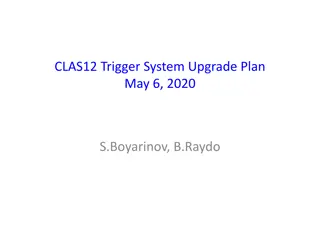LHCb RICH2 Upgrade Mechanics Status Update November 2016
Mechanics and design status update of LHCb RICH2 upgrade focusing on T-bar and cooling system construction, cable tray design, connections, cooling geometry optimization, prototypes testing, and assembly progress. Details include materials used, dimensions, heat exchange calculations, pressure drops, and expected coefficients for efficient cooling.
Download Presentation

Please find below an Image/Link to download the presentation.
The content on the website is provided AS IS for your information and personal use only. It may not be sold, licensed, or shared on other websites without obtaining consent from the author. Download presentation by click this link. If you encounter any issues during the download, it is possible that the publisher has removed the file from their server.
E N D
Presentation Transcript
LHCb RICH2 Upgrade Mechanics November 2016 Massimo Benettoni, on behalf of RICH2 Padova group RICH2 design status 1
T-bar and Cooling T-bar construction: prototypes in two pieces received, likely made of laminated plates AW6083 vs cast plate => out of planarity up to ~1 mm Requiring careful assembly to optimize streightness (RICH2 bars could be one single piece) Cable tray Dimensions and design depending on services DEBs: thermal coupling for DEBs dissipating components Services: From T- bar to gas patch panel without patch panels? Connections on board T-bar: PDM HV patch panel Fibers splicers Cooling: Two ducts, go and return Drop of pressure compatible wrt available Dp ~ 0.7 bar Optimized ECs and DEBs cooling 2
Cooling geometry Found deep-drilling feasible as small as 5 mm Calculations of heat exchange and pressure drop, range 5 to 10 mm diam. (flow to get Dt out-in of 5^C => water: ~ 1 l/1 , C6F14 Qe =1 lw/1 ~ 2.4 l/1 ) Small diameters (<7 mm) are more efficient than 10 mm with 8 mm cyl inserts 5 mm diameter pressure drop seems to high wrt overall 0.7 bar available 6 mm diameter seems best choice (one duct, 1.4 m long) 4 Condotto cilindrico 3.5x 10 ACQUA C6F14 NOVEC 649 NOVEC 7100 LIMITE 3 2.5 Caduta di pressione [Pa] 2 1.5 1 0.5 0 5 6 7 8 9 10 11 12 -3 Diametro [m] x 10 3
Cooling geometry No more need of inserts or baffles => simpler production Expected pressure drop with 6 mm duct diameter < 0.3 bar (ducts only) Expected heat exchange coefficient with 6 mm duct diameter: 2.3x wrt 10mm circular duct (1stprototype) 1.4x wrt 10mm duct with 8 mm cyl insert (hydraulic diameter ~ 3.6 mm) 5 C6F14 6x 10 D = 5 [mm] D = 6 [mm] D = 8 [mm] D = 10 [mm] Condotto anulare LIMITE 5 Caduta di pressione [Pa] 4 3 2 1 0 0.8 1 1.2 Portata equivalente Qe [l/m] 1.4 1.6 1.8 2 4
Cooling geometry Test of T-bar with single 10 mm duct: baffles wrt to no baffles Water, Tin = ~ 21 C , Tout ~= 26 C, Q~ 1 l/1 , P~350 W NO BAFFLES Average bar temp 28.8 C T min face EC ~ 25 C T max face EC ~ 28 C Max bar temperature ~ 31.5 C BAFFLES Average bar temp 26.4 C T min face EC ~ 22.5 C T max face EC ~ 26.5 C Max bar temperature ~ 29.5 C Fine! but Dprex (water) @1 l/m: 0.21-0.27 bar/m => C6F14 likely not acceptable 5
Prototypes Prototypes built in 2 pieces: Flange to ECs 12x55 mm plate deep-drilled blade, 15x90 plate, duct diameters: 5, 6, 8, 10 mm Prototypes received on Nov. 4, quick check on granite table Planarity of blades from very good (<0.2 mm) to bad (~ 0.8 1 mm) under cleaning at LNL, then assembly and measuring 4+4 pcs to be returned to company for shipping to Cern Prototypes available: - 2 blades w/o ducts (gift) sent to Trevor @ Imperial - 2 blades 10 mm duct - 2 blades 8 mm duct - 1 blade 6 mm duct - 1 blade 5 mm duct - 6 flange plates (facing Ecs) - 2 additional base plates (gift) sent to Trevor @ Imperial 6
T-bar endblocks design Cooling circuit sealing vs C6F14 NBR and PUR seem ok... https://detector-cooling.web.cern.ch/detector- cooling/data/Fluoro_Compatibility.htm Increasing prototype bearing dimensions and pitch to reduce preload HV-pp preliminary design (Flavio F.) 7
DEBs thermal interface Updated design, proposing e.g. 0.5 mm copper sheets to reach bottom of DCDC
PDA: rack, rails, maintenance Review design of rack maintenance scenario: move back rack mount rails extensions extract column rotate column Bar rotation: cable chains vs bundled services Services extralenght to allow rack and column retraction and access without disconnection Services cross section vs cable chain (~ 10 cm2) 9























